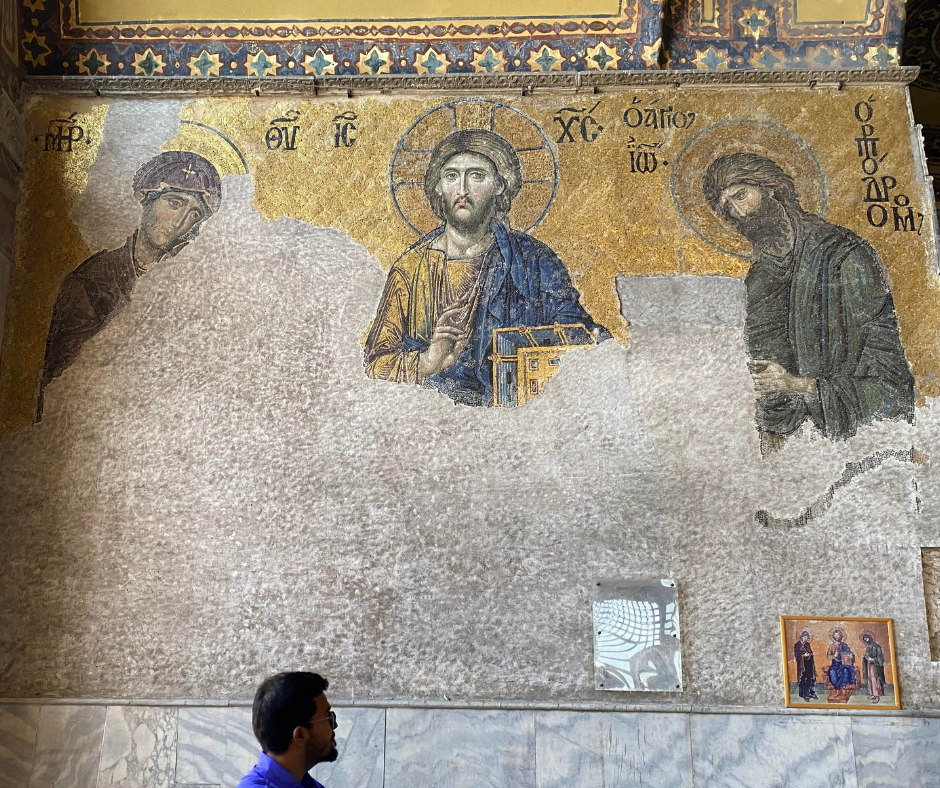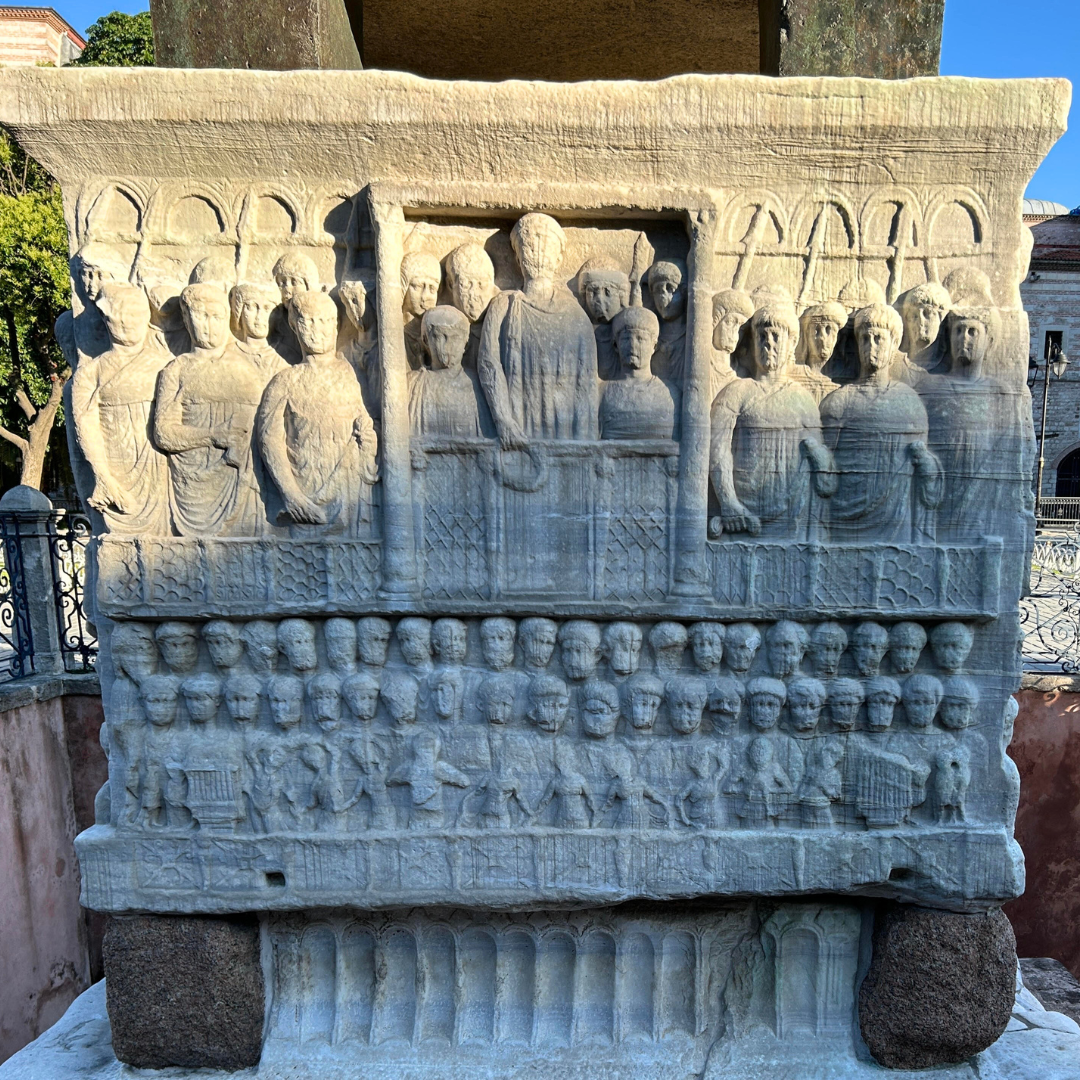Theodosius I: Zealous for a Christian Empire
A guest post by Arunansh B. Goswami

Author in the Hagia Sophia. Photo credit: Professor Arkaja Goswami.
Having already visited three of the five Patriarchal Sees, namely Jerusalem founded by St. James, Rome founded by St. Peter, and Alexandria founded by St. Mark, I decided to continue my journey to learn more about the early Christian Church and recently visited the Holy See of Constantinople (Istanbul), founded by St. Andrew, the "first-called among the Apostles." It is also the home of the Patriarchate of Constantinople, the spiritual center of the Orthodox Church, seen as a mother church by the autonomous churches of Russia, Serbia, Romania, Bulgaria, Georgia, Cyprus, Greece, Poland, and Albania, and by the autonomous churches of Czechoslovakia, Finland, and Estonia.
Constantinople was named after Roman emperor Constantine the Great, who transferred the imperial capital here in 330 AD. Now, what used to be Constantinople is part of a larger Istanbul city straddling two continents—Asia and Europe—and has much to offer students of early Christianity. Constantine himself was buried at The Church of the Holy Apostles located at the site of the present Fatih Mosque. He is credited with the origin of the concept of the convocation of a universal or ecumenical council of the bishops of the entire Church, assembling in order to solve questions disturbing the peace of the Church. He convoked the first Ecumenical Council at Nicaea in 325, in which was promulgated the Nicene Creed, a Christian statement of faith that was enlarged in the Council of Constantinople in 381, when Theodosius I the Great was the emperor, which came to be called the Niceno-Constantinopolitan Creed. In this article, readers will learn more about the life and legacy of Emperor Theodosius the Great.
The emperor and the church
In the Sultan Ahmet Square, in what used to be the Hippodrome of Constantinople, is the obelisk of Theodosius I. The following inscription is found on its pedestal, giving information about his reign. “Once it was difficult to conquer me, but I was ordered to obey mild masters and to carry the subdued tyrants' palms. Everything belongs to Theodosius and his eternal descendants. Thus conquered, I was tamed for three days. When Proclus was praefectus urbi, I was erected to the skies.” But who was Theodosius I? A native of Spain, Flavius Theodosius was the last Roman emperor to rule a unified empire of East and West.
He holds an important place in the history of Christianity for putting an end to the last of paganism and the Arian heresy in the empire, and is venerated in Eastern and Orthodox churches. He is criticized too for his excessive persecution of pagans and the massacre of 7,000 people in Thessaloniki; for the latter, he repented after being rebuked by St. Ambrose of Milan and being called by him to repent. Mark Hebblewhite writes in his book Theodosius and the Limits of Empire, that “at one of the more important of the interminable ecclesiastical gatherings of the fifth century, he was referred to with the sobriquet of “megas'' or “great.” He is referring to the Council of Chalcedon, convened by Marcian; it was this council that established Christian Orthodoxy.
First Council of Constantinople
Theodosius convened the First Council of Constantinople (the second ecumenical council of the Christian Church) probably in Hagia Irene Church in 381 AD, which is located in the outer courtyard of Topkapı Palace and is the oldest church of the Eastern Roman Empire (Byzantine). Deno John Geanakoplos writes in his book Constantinople and the West,
In the long annals of the Christian church, it is the First Council of Constantinople held in that capital in 381 that marks the emergence of the see of Constantinople to preeminence over the Eastern sees of Christendom. More important, theologically, it was at this council that the most fundamental of Christian doctrines, that of the Trinity, was completed, with the Holy Spirit declared, at least implicitly, to be divine and homoousios with the Father and the Son in the Godhead.
Theodosius I promoted Nicene Trinitarianism within Christianity and Christianity within the empire. K. W. Harl writes in his research paper “Sacrifice and Pagan Belief in Fifth-and Sixth-Century Byzantium” that
The emperor Theodosius I (379–95), impelled by a mixture of piety and political calculation, banned public and private sacrifices and ordered the closing of pagan temples in three edicts issued during 391-2. Along with blood sacrifices—long offensive to Christians—such pagan devotions as sprinkling incense on altars, hanging sacred filets on trees, and raising turf altars were classified as acts of high treason punishable by death and confiscation of property. There was no mistaking the intent of Theodosius' laws: henceforth, Nicene Christianity was the official religion of the empire.
Opposing paganism
Zosimus, an early Byzantine pagan author of a history of the Roman Empire, wrote about Theodosius’ address to the Roman Senate, saying
Theodosius exhorted the senators to abandon their paganism and turn to Christianity. The senators all refused to forsake the gods, who had kept their city from destruction for nearly 1,200 years. Theodosius then informed them that the cost of the pagan ceremonies would no longer be borne by the state: (a) because he did not approve of state funds being used for such a purpose, and (b) because he needed the money to pay his troops. The senators protested that the sacrifice could not be properly performed except at the public expense. But they were ignored, the state subsidies were withdrawn, and the ruin of the Western Empire inevitably followed.
Zosimus’ pagan bias is evident from his description, but his description shows Theodosius’ deep faith in Christianity and opposition to paganism.
Because of his contributions to the spread of Christianity, Theodosius I is venerated in Eastern and Orthodox Churches, but is criticized vehemently by those who consider his persecution of pagans as not behooving of a Roman emperor who should ideally treat people equally irrespective of the faiths they profess. For students of the early history of the Church, it is indeed important to study about Theodosius I because of his enormous contributions to the history of the Church. There is much more that can be written about him and can be learned about him in the city of Constantinople, now Istanbul.

Depiction of Emperor Theodosius I on the pedestal of obelisk of Theodosius I in Istanbul. Photo credit: Arunansh B. Goswami.
Arunansh B. Goswami is a lawyer and historian based in India who writes for several publications worldwide.
For more on creeds, councils, and empire in the early church, read issue #85, Council of Nicaea: Debating Jesus' Divinity.



